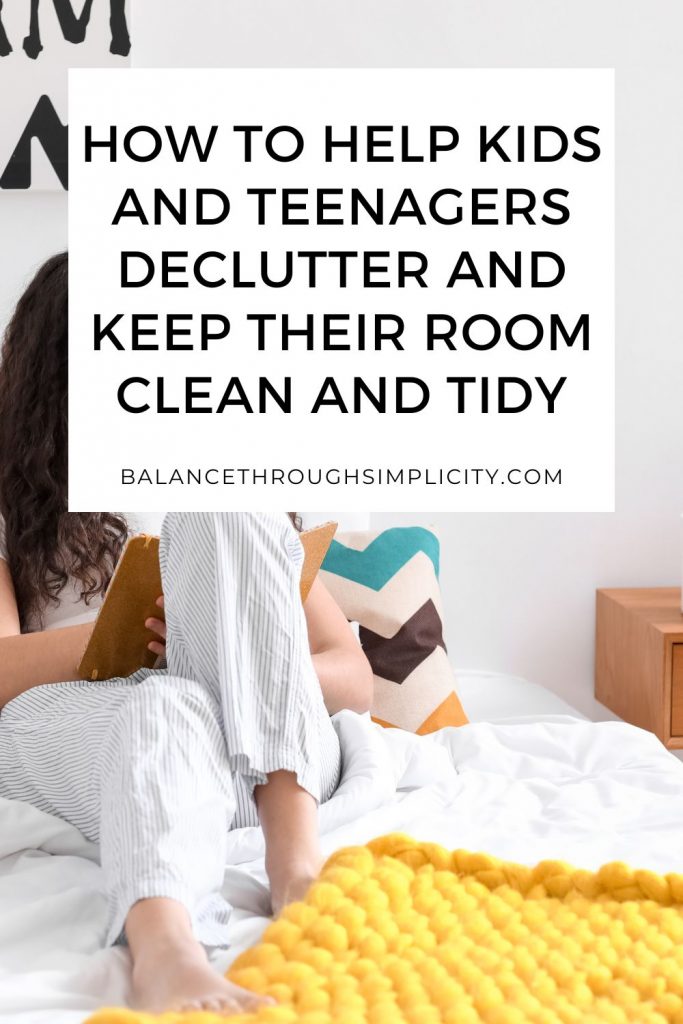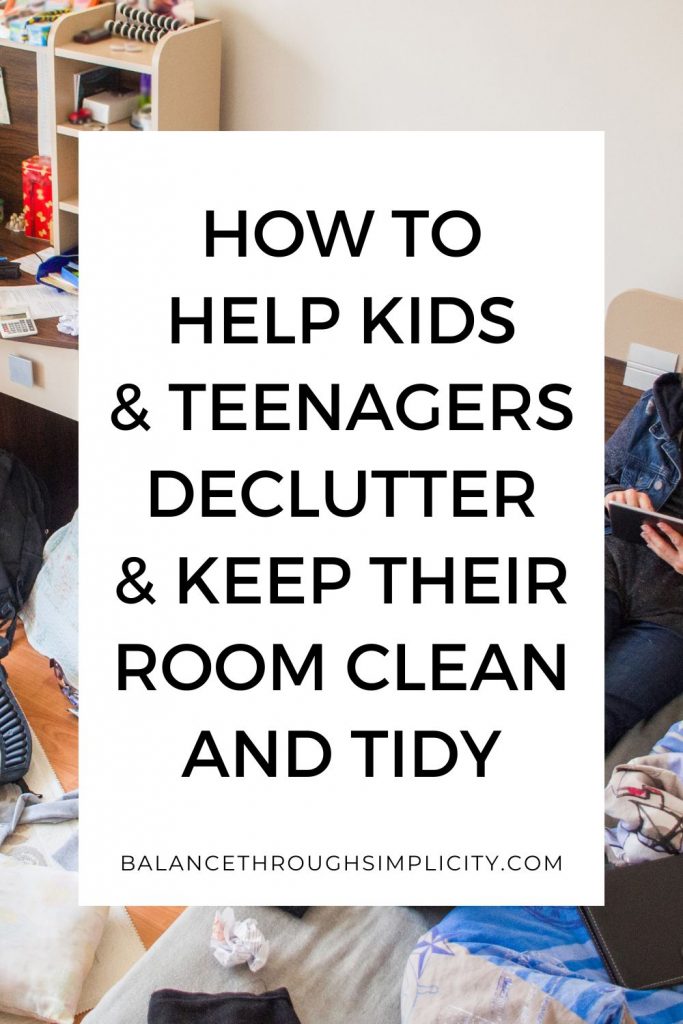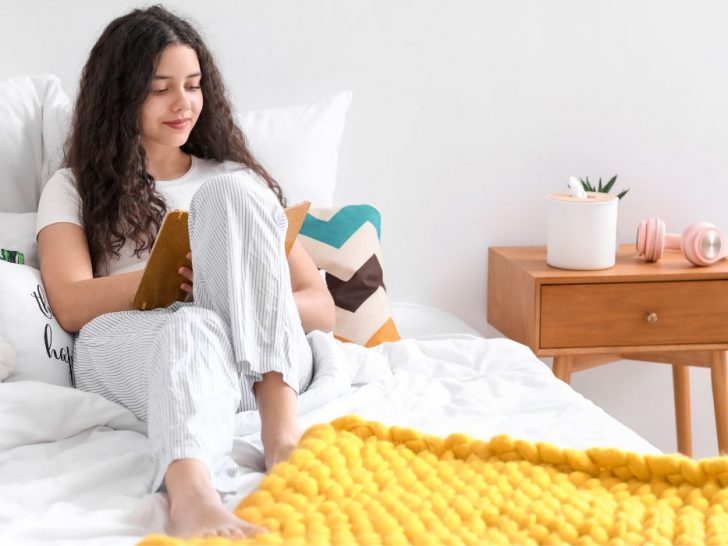HOW TO HELP KIDS AND TEENAGERS DECLUTTER AND KEEP THEIR ROOM CLEAN AND TIDY
For those of you with older kids and teenagers, you may be familiar with the struggle to keep them motivated. This is even more difficult when you’re trying to motivate and encourage them to help around the home and clear up after themselves! If this resonates with you, here are some tips on how to help kids and teenagers declutter and keep their room clean and tidy.
GETTING OLDER KIDS AND TEENAGERS TO HELP AROUND THE HOUSE
I have two daughters, currently aged 11 and 14. One is naturally neat, tidy and organised and quite enjoys looking after her room and helping out more generally around the home. My eldest daughter is the opposite and struggles to keep her desk tidy, let alone organise her room, her school bags and work and her life! I received an email from a reader recently who is struggling with the same problem, motivating her teenager to do chores in her room and around the house, so I thought it might be helpful if I share some personal tips of what works in our home and how to help kids and teenagers declutter and keep their room clean and tidy. It seems that this is a struggle for many parents of older kids and teenagers!
MOTIVATING YOUR KIDS AND TEENS
Child and teenage brains are still developing and the raging hormones that come with puberty often mean that emotions run high and motivation runs low, especially when it comes to tasks they don’t really want to do – tidying and cleaning are two that come to mind as the topics of this article!
Whilst adults and kids generally tend to benefit from structure, framework and routine, building these good habits consistently in place tends to take time, hard work, perseverance and a fair amount of banging your head against the proverbial brick wall. My kids would rather be out and about with friends, listening to music, lost in the screen or (at least for one of my kids) doing just about anything else than helping out with housework and chores. Motivation seems to play a key role in this and motivating oneself to clean and tidy can be difficult for many of us.
WHY I THINK WE SHOULD ENCOURAGE OUR KIDS TO HELP AROUND THE HOUSE
There are two key reasons why I think we should encourage our kids to help (age and ability appropriate) around the house, and especially to take ownership of their belongings and rooms from as early as possible.
1. Saves time and shares the load
I’m a full time working parent, not necessarily by choice but by financial necessity. I’d love to be able to take care of my family, cook and clean, without also having to worry about work deadlines and commutes, but we can’t afford it. Sharing the load of the housework when we all contribute to making a mess in the house saves me time and energy. This is time and energy that I can pour back into my family and myself without feeling worn down, resentful and frustrated. I’d rather be playing a board game with my kids than tidying their rooms at the end of a long day. I think they’d probably prefer me to be playing that board game with them too than angrily tidying their stuff!
2. It teaches them personal responsibility for later in life
Part of adulting is, for most of us, looking after our stuff and keeping our homes and selves clean and presentable. I want my kids to be independent and self-sufficient and knowing how to tidy their rooms and help with laundry and other chores is key to that. Encouraging them to help with housework is a valuable skill for later life when they move out and live on their own, with friends or with their own families and developing the ability to clear and tidy after oneself also teaches us where our natural skills lie and where we need some extra help. Our outer environment (our home) says a lot about how our inner environment (our mind) works.

TIPS TO HELP KIDS AND TEENAGERS DECLUTTER AND KEEP THEIR ROOM CLEAN AND TIDY
Here are some tips to help kids and teenagers declutter and keep their room clean and tidy. If you have any other tips to add to this list which might help others, I’d love to hear from you. Please leave a comment at the bottom of the post!
1. Set a timer
Working in short bursts always feels easier. Instead of a never-ending list of things to do, set a timer for 5 or 10 minutes and work til it goes off. Small tasks seem less daunting than big projects which go on and on.
2. Make decluttering, tidying and cleaning fun
Play some music, get on a call with a friend, have the TV on in the background. As long as your child won’t get distracted and stop to listen, chat or watch, let them make decluttering, cleaning and tidying fun. If it’s fun, they’re much more likely to want to do it again!
3. Create reward and incentive
“If you tidy your room, I’ll drop you to the park to meet up with your friends.” Wherever possible use positive rewards and incentives to encourage good behaviours and results. Use the things and activities that your child wants to do to create leverage and get the most out of them!
4. Repeat to build up good habits
Decluttering, cleaning and tidying are all done best in short bursts. It feels easier, is more effective and stops the build up of clutter, grime and mess instead of leaving it for days or weeks on end and having to deal with the aftermath. Building good habits such as daily and weekly maintenance is done by repeating the same action, over and over. With time, these habits become embedded into the natural rhythm of your day or week. It may take time (reminding and encouraging) for your teen to build good decluttering and cleaning habits but persevere and eventually they may see and feel the benefit.
5. Find the best time of day
My eldest daughter is a night owl and prefers to tidy, clean and clear (if it has to be done at all) in the evening. Asking her to do these things in the morning is a recipe for disaster. It’s difficult enough getting her up and out of bed in time for school, let alone adding in tasks that she doesn’t want to do in the first place. Find the best time of day that suits your child to do their chores and tidying and make this part of the regular routine for that time of day.
6. Consider storage solutions for ease and speed
My youngest daughter loves sorting and arranging her clothes, jewellery, Lego and toys into small, individual drawers, drawer dividers and containers. She loves micro-organising and can maintain this easily and with enjoyment.
My eldest daughter chucks clothes on the floordrobe (floor – wardrobe), and stuffs the rest, out of sight and out of mind, at the back of her wardrobe, in stacks on her desk or the corner of the floor. When she and I looked around to assess where and what stuff piles up the worst, we decided that the problem was two-fold. Firstly, she had too much stuff (we’ll come to that point in a moment) but secondly, the storage and organisation systems she had didn’t match her needs and abilities. She’s very much a macro-organiser and prefer big containers and boxes to throw things in quickly and easily.
We swapped hanging space and small drawers and compartments for big boxes, clearly labelled and easily accessible on shelves, in her wardrobe and by her desk and she uses these to collate her stuff into the different categories. Clothes and paperwork may be a bit crumpled but she can put it away, find it and take it out much more easily. And, when things are easier, they’re less overwhelming, met with less resistance and easier to keep up.

7. Laundry basket in room
Instead of dirty clothes strewn around the floor and hanging over chairs, try a laundry basket tucked in the corner of the room. Make it as easy to throw dirty clothes in there as it is to throw them on the floor and their bedroom will look clear, clean and tidy more often. Build a habit of getting your child to empty their individual laundry baskets into your main basket (or put their own wash on if they’re able to) and that’s a bonus. Choose a basket that suits the décor of your child’s room so it matches the room’s style as well as being functional.
8. Rubbish bin in room
As for the laundry basket above, give your child their own waste bin to keep rubbish neat and tidy and get them to empty this regularly.
9. Limit flat surfaces
Flat surfaces are clutter hotspots for many homes. Clutter attracts clutter and it’s easy to put something down on a table top, window sill, shelf and, over time, more clutter will add to that first bit of clutter. Before you know it, you’ll have a whole pile of clutter to deal with. Remove unnecessary furniture and think carefully about how many and where the flat surfaces are in your child or teenager’s room to limit the build up of clutter. Clearer flat surfaces also give a clear line of sight and the illusion of more space. How to help kids and teenagers declutter and keep their room clean and tidy very much depends on looking at where the pain-points are and removing the root cause of the problem.
10. Maximise hidden storage and use vertical storage space
My girls have beds with drawers built in underneath. They use these drawers for blankets, spare bedding and, for my eldest who loves art, her canvases and paper. Hidden storage is a great way to maximise space in a smaller room.
Vertical storage space is also a great way to make use of all available space. You can get storage solutions for the backs of wardrobe and cupboard doors, hooks and pegs to stick on walls or the backs of doors. They’re an easy way to hang things up and keep them off the floor.
11. Make the bed
Every morning when my kids were little I used to ask them to pull the four corners of their duvet to the four corners of their bed. Years later they do this pretty much every day. A tidy bed is a good habit to signal your brain to begin the day. A made bed also makes the room feel neater and tidier even if it’s not so clean and tidy on close inspection.
12. Keep the floor clear
Just like a tidy bed gives the illusion of a tidy room, so too do clear floors. Use storage options as discussed above to find strategies to keep clothes and random junk off the floor. If the floor is clear, the room looks bigger and tidier and you can walk from one side to the other without having to watch what you’re treading on – and it makes vacuuming easier too!
13. Limit décor and accessories
My eldest daughter, who struggles to keep her room clear and tidy, is encouraged not to have throws and cushions to decorate her bed. Excess cushions, apart from the pillows she uses to sleep on at night, are just extra faff and clutter for her to remember (or not) to put on each day as she makes her bed. Knick knacks and ornaments on the tables and shelves are yet more stuff to be looked after, tidied and dusted so we try to limit these too. That’s not to say that her bedroom isn’t cosy and full of character and expression but she finds ways to layer this up without adding lots of extra stuff. Some examples of things we do is make use of interesting lighting, switch bedding often for different colours, patterns and textures and ring the changes with different wall art on her wall and pinboards.

14. Put rules in place
As much as possible I like to reinforce good behaviour and habits with positive incentives and rewards but occasionally I find myself resorting to some rules. Some recent examples might be no food or drink in their room if plates and glasses aren’t returned to the kitchen for washing daily. Or, they won’t have clean clothes to wear if their dirty laundry isn’t added to my main bathroom laundry basket. Sometimes they have to live with the consequences of these rules but over time, they do what they need to do to have clean clothes and take a snack to their rooms!
15. Make cleaning a weekly schedule
For many of us, it’s easy to let cleaning and decluttering slide. We put it off until tomorrow, when we feel like it, or when we have more time. However, doing a little bit often is a great way to keep our home maintained with minimal energy. It’s one of the ways that I spend much less time cleaning by having a rota and doing 15-20 minutes of cleaning every day, rather than a deep-clean session during my precious weekends! The same idea could apply to your kids and how they clean their rooms or contribute to cleaning the rest of the house.
Make a weekly cleaning schedule for your kids. Here are some daily and weekly ideas to include for their own room, depending on their age and ability:
Daily chores:
- Dirty glasses, plates etc to the kitchen
- Dirty clothes into the laundry basket
- Put clean laundry away
- Clear the floor
- Make the bed
- Tidy away all toys
- Tidy away all make-up
- Sort and organise school bag and school work
Weekly chores:
- Changing the bedding
- Vacuum and dust
- Tidy your desk
16. Use phone/Alexa to set alarms, alerts and reminders
This tip to help your child or teenager declutter and keep their room clean and tidy is something I do for myself. I use my phone or Alexa to set all sorts of reminders including placing my weekly online grocery order, when to walk the dog, when to put the bins out on bin collection day. My kids also have alarms to wake up at a certain time for school, a 15-minute countdown on school days so they have plenty of warning before we leave for the house for school and work, plus an evening reminder to start their evening routine and get ready for bed. Using my phone or Alexa in this way stops me having to remember things in my busy brain and gives my kids some responsibility for their own time management.
17. Praise good work
I’ve learnt through trial and error that nagging doesn’t work. It just makes me feel frustrated and angry and my kids switch off. So, I find it better to reward and praise when things go well. When they go wrong, we look at why they went wrong and aim for a better time tomorrow.
18. Morning routine
Just like adults, kids can benefit from a constructive school run morning routine to prepare them for the day ahead. This, of course, means having a healthy and sustaining breakfast and brushing their teeth but also making their bed, packing school bags (if not done the night before) and giving their room a once over before they leave for the day including turning off lights etc. Again, it might be helpful to write down this morning routine and go through it with your kids to make sure they have input and know what’s expected of them. Put timings against all the activities to help them manage their time, their room and chores and not start the day rushed and stressed.
19. Evening routine
The end of the day sets the tone for the night ahead so I encourage my kids to put their rooms to bed like they do themselves. This includes packing school bags and checking what they need for tomorrow (PE kits/food tech ingredients) but also putting all toys, books, makeup etc away. They also tidy their desk, take down any dirty plates etc and close down all devices. Again, a list or some kind of visual reminder of what’s expected might be helpful. It doesn’t need to be big or obtrusive. My eldest daughter just has a little post-it note size list stuck on her mirror to keep her focused and remind her.
20. School work
As kids become teenagers and move from primary to secondary school, they’re expected to work more independently and manage their time and belongings more responsibly. Some kids find this no trouble whilst others struggle. We’ve found that keeping on top of school stuff (uniform, PE kits, books, papers, stationery, bags etc) is easier for my disorganised eldest daughter when we check them daily/regularly and use big and clearly labelled bins and boxes for the different items.
21. Make sure everything has a home for when not being used
The same goes for other items that kids and teenagers often have in their rooms. Keep everything separate, easy to put away and make sure that everything has a ‘home’ – a place to be kept and stored when not in use. Some examples of items that need a ‘home’ could be arts and crafts supplies, make-up and hair accessories, computer/xboxes and other devices etc.
22. Good enough vs perfection
My idea of a clean and tidy room is different to my daughter’s but as long as her room is clean and clear enough then that’s good enough for me. I’d rather she learn to enjoy looking after and maintaining her room and the stuff in it in a way that’s manageable to her than trying to fit my idea of a neat and tidy room and getting frustrated and demoralised. Progress not perfection and good enough is good enough.
23. Visual organisers
My eldest daughter is a visual organiser and prefers everything to be out where it’s clearly visible and easy to find. If I ask my eldest to put things in drawers or tucked out of sight she’d forget they were there or wouldn’t be able to keep up with such an intricate organisation system. Again, this is where it’s helpful to choose bigger storage solutions, buckets and boxes to group similar clutter. It can still look good and be in the same style and décor as the rest of the room but it’s using organisation skills that suit my daughter more naturally.
24. Offer help
If my kids struggle with keeping their room clutter-free, neat and tidy, I offer to help them. Usually they say no but I’ve set the expectation that the room needs to be cleaned and cleared but that I’m happy to help. I don’t offer all the time, but just when things have got on top of them and they need an extra boost of encouragement.
25. Declutter
The easiest and simplest way of helping your child or teenager keep their room tidy and clean is to declutter and give them less stuff to manage. It’s difficult to let a room get messy if they have limited stuff in it to begin with. Living with less stuff is a mindset shift for all of us and probably not a lifestyle choice that you can spring on your kids just like that. It takes time to understand how and why to choose less over more. However, give it time, show them the benefits of how having less stuff makes it easier to look after what they do have and with a bit of luck and perseverance, your family might come to understand and enjoy the benefits of a decluttered home. You can read more about decluttering toys or how kids benefit from having fewer toys if you’re interested to learn more about this topic.

IN SUMMARY
I hope you found these tips useful to help your child or teenager declutter and keep their room clean and tidy. It’s definitely something that takes time and perseverance and probably won’t happen overnight but the results are well worth it. Set reasonable expectations for how they can look after their stuff and what they need to do, teach them to take individual responsibility for their space and their stuff and this will be a valuable life skill for the future.
If you have any thoughts or ideas to add, please leave a note in the comments!
GET YOUR FREE PRINTABLE…
A clear decluttering action plan to help you decide WHAT to declutter, WHEN to do it and HOW. Simple steps for quick, easy decluttering!
DON’T MISS OUT!
I’m Antonia and on this blog I share practical inspiration to simplify your home, time and life. Follow me on Instagram, Facebook and Pinterest! You can also subscribe to Balance Through Simplicity and receive regular simplicity tips straight to your inbox for free. Make sure you never miss an article plus you’ll get a copy of my free Declutter Starter Kit as a welcome gift!

